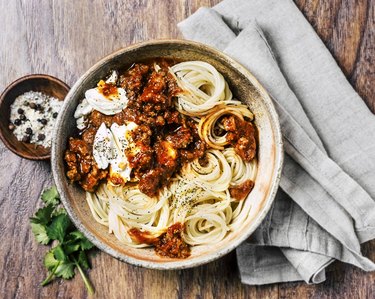
If you've ever ended up with leftover pasta or noodles, you know that it's hard to reheat noodles in the microwave. Reheated pasta can be gummy and even have crunchy bits around the edges. The best way to reheat noodles without sauce involves a few additional ingredients, like water, milk or oil.
Read more: Cut Calories With These 9 "Pasta Poser" Recipes
Video of the Day
Video of the Day
How to Reheat Pasta
If you want to reheat pasta without it becoming gummy or crunchy, you may need to try a few different strategies. Whole grain pasta, which the Harvard T.H. Chan School of Public Health considers to be better for you, may be more challenging to reheat because of its coarser, grainier texture.
The exact way you need to reheat your pasta will depend on whether or not it has sauce. If your pasta has no sauce added, you can add a tablespoon or two of water to the container that you're heating it in. You can do the same thing with oil if your dressing or sauce is oil-based, like pesto.
The USDA Food Safety and Inspection Service recommends that you cover your container of food with plastic wrap or another cover before microwaving. This cover helps your food stay moist and stops it from becoming crunchy. It also helps your food cook all the way through.
Make sure any lid you use isn't tightly sealed around the container. If you're using plastic wrap, you can pop a few holes in the film. You're essentially steaming your pasta and need to allow the trapped steam to escape. This allows for your pasta to heat evenly.
The USDA also says that you should stir food halfway through microwaving it in order to make sure that it's heated evenly. It's best to heat your pasta at low heat for short periods, stir, and heat again rather than heating it for a long duration at high heat. High heat is more likely to make food gummy, chewy or crunchy.
Heating your pasta for a minute or two is usually best, but the exact duration of time your pasta needs to cook depends on how much pasta you're reheating and other ingredients, like meat, that might be in your pasta sauce. According to the USDA, your pasta, casserole or other dish has been fully reheated when it's reached an internal temperature of 165 degrees Fahrenheit or 74 degrees Celsius.
Reheating Pasta With Sauce
If you want to reheat pasta with sauce that's already been added, you'll still need to add a little oil, water, milk or cream. What you choose to add will be determined by what your pasta sauce is made from.
Vegetable-based sauces like tomato sauces tend to already have water or small amounts of oil added to them. This means that you should add oil or water to the mixture when you reheat the pasta. This is fairly simple, as you would reheat this pasta in the same way as pasta without sauce.
Do not add water to creamy sauces, like pasta with Alfredo sauce, truffle sauce or garlic butter sauce. You'll need to add a little milk, cream or even oil in a pinch.
Finally, pasta sauces can also be made from vegan ingredients. For instance, you might have creamy cashew nut pasta sauce or vegan pesto pasta sauce made with walnuts or pine nuts.
These creamy plant-based sauces are typically healthier for you than creamy butter or milk-based sauces because they have less saturated fat. The American Heart Association recommends consuming less saturated fat and more monounsaturated and polyunsaturated fats, when possible.
In such cases, you should avoid adding water, milk or cream. Instead, it's best to add oil. A nut oil similar to the one you cooked with is best, but you can also use other products — like extra virgin olive oil, flaxseed oil or sesame oil — based on the sauce. In certain cases, you may be able to add coconut milk or cream as well.
Was this article helpful?
150 Characters Max
0/150
Thank you for sharing!
Thank you for your feedback!